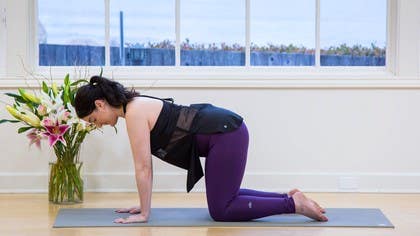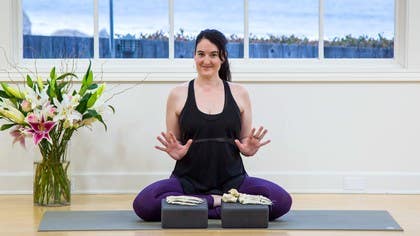Description
About This Video
Transcript
Read Full Transcript
A really common posture that we do in almost every vinyasa-style class, and I think that often it's done so excessively and under-taught that most students, it's not really setting them up for success. Remember, we're not really good at bearing weight on our arms, so we have to be taught, we have to learn to make it more efficient and more joyful, because chaturanga dandasana can be a drag. So just as an example, take your arms forward, like a sleepwalker, and then just extend through your wrists. Now imagine there's like a big elephant's tush right in front of you for some reason. Now reach your arms slightly off your back, like you're really reaching for the tush, and then try to push the elephant away.
Push it, push it, push it, push it, push it, push it, push it, push it, push it, push it. And then come back, take the arms forward, now bring the shoulder blades, just kind of muscarily glue them onto the back, same elephant's rear end, and then push him. Push, push, push, push, push, push, push. Which time did he move? Second time.
So when we have just the arms doing the heavy lifting, we just have the muscles of the arms doing that action. And Linda is incredibly strong and can do a lot of fancy stuff, but there's limits. She can only have just the strength of her arm. Now when she brings the shoulder blades on her back, muscarily, then she has the whole rest of the body integrated into that action. So it's not just her arms, she's not just relying on that, but the whole integrated body behind the action.
Now this is mystical to most of us when we begin. So I'd like to introduce you to something called the serratus anterior. This muscle for most of us is a little bit hidden. If you want to YouTube and look up body builder, sometimes you can see, it has a very kind of iconic look to it. And it looks like what it sounds like serrated, it looks like one of those serrated knives.
So it has these kind of ripply edges and it exists on the sides of the ribs here. It dives underneath the scapula and then attaches to the medial border of the scapula. And so it's one of those muscles that forms the scapular glue to keep those really highly mobile shoulder blades in place, right? It's hard to find this muscle. We don't usually cue into it too much in life.
So I like to do something that's called a serratus pushup or a straight arm pushup. Don't be scared. It's not too bad. If you are new to placing weight on the arms, you could always do this at a wall. If you feel that you are ready to place some weight on the arms, we can try it on our hands and knees.
So I'm going to have Linda come up to her hands and knees. Just set up like you would a tabletop posture, wrists right underneath the shoulders. She's going to keep her belly a little bit active, nothing wild, but just to support her lower back. Her head and neck are going to stay elegant, so there's no stress happening here. Now she's going to straight arm pushup, so she's going to keep her elbows straight.
And then she's going to start breathing a little deeper and then on her next inhale, she's going to puff up the back of her heart and kind of protract the scapula away from one another. And then on her exhale, she's going to melt her heart in between her two arm bones, almost like a hammock between two tall trees. She's just going to do it a couple of times on her own, inhale, kind of filling up the space behind her heart, and then her exhale kind of hammocking. And then just go about 80% of your range, so no need to kind of jam into the outer reaches of our range. We're just trying to find this kind of deep, intrinsic muscle of stability and stickiness.
Now if this is comfortable and she's like, yeah, I could work with this a little bit, then we can take it into plank pose. So if she's willing, she can step back into plank and then just do the same exercise. So the inhale, she's going to fill up this space behind her heart, kind of puffing it up like a balloon. And then her exhale, she'll melt the heart, about 80% of her range. Good.
One more time, I want her to, I want to stay friends. Good. And then just come onto your knees for a moment, take a little break on your knees. Now both of those postures are not really what we're looking for in Chaturanga. Really what we're looking for is the midway between those two extremes.
So instead of asking ourselves for this big, mysterious movement straight off, we can adapt the pose for our students for ourselves first. So one way we can do it is we can come to plank, find the midway between those extremes. So there's a puffiness behind the heart, a broadness in the backs of the shoulder blades, right? But the arms are still integrated into the body. And then we can try to lower the body down in one piece, everything down to the floor in one lovely, perfect piece.
Yeah. Good. Then once we have that, then we can start working with lowering just halfway down. Otherwise, we really have no chance in supporting that action well. Yeah?
Thank you.
Your Body on Yoga: Upper Appendage
Comments
You need to be a subscriber to post a comment.
Please Log In or Create an Account to start your free trial.










